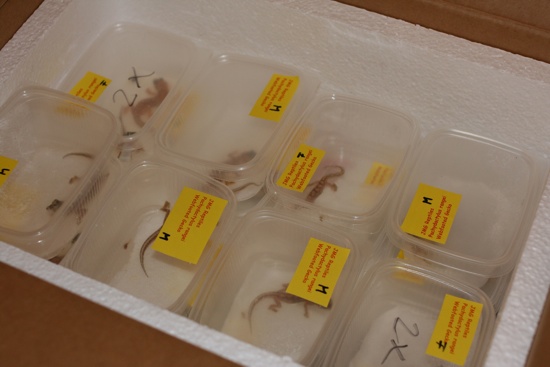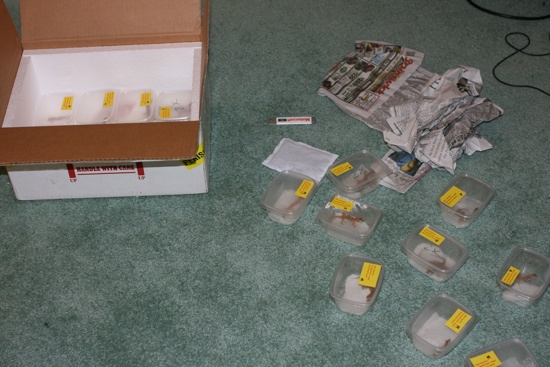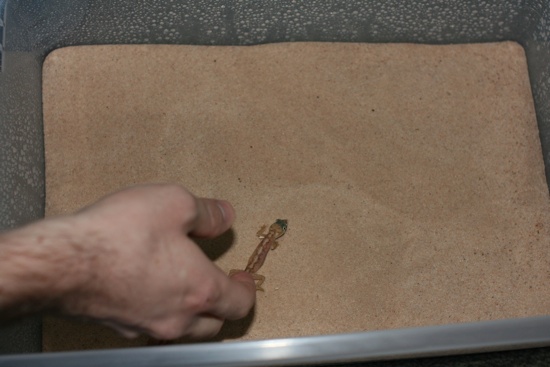Over the last two weeks we have discussed Namibia, and a gecko that hails from that region. This week I’d like to share my experience importing P. rangei from Germany to the United States.
[ad#sponsor]
I’ve long wanted to keep P. rangei; it was on my list of top five species to acquire when I got back into the gecko keeping game. It was something about their eyes, and my inability to find them very often.
Here’s how I went about deciding and importing one of the species I’ve always wanted to keep. It could serve as a guide to anyone who wants to import an animal from outside the US.


First Steps
First, establish what the market for the species is. In the US I very rarely saw P. rangei. They are a “rare” gecko, often selling for $100-$125 per hatchling. I couldn’t find any available when I was looking so I started to scour the forums.
I finally found some photos of the gecko I had been searching for on Geckos Unlimited. I found one of the largest breeders of rangei in Germany, Steven Arth.

Research

Learn as much as you can. I had no idea that in Germany there were some interesting requirements for selling reptiles. At shows your containers must have opaque sides, be labeled with a scientific name, contain some sort of natural substrate (no paper towels), and have enough space for the animal to fully stretch from side to side without touching.
As I researched I found many reputable breeders in the United States that advertised the ability to import from Hamm, Germany shows. Because I did not want to take on learning curve how to do this myself, and because I don’t plan to do this multiple times in the future, I wanted to hire someone to bring these geckos in for me. I quickly discovered that people charge based on the size of the animal. Most leopard gecko breeders will charge $45-55 per animal brought in. It’s possible to get a lower rate, with smaller animals and a higher number of animals being imported.
Act
I decided to use JMG Reptiles to help import my geckos. After a 3-4 day trip from Hamm, Germany to JMG’s facility we then had to wait for the next available Monday or Tuesday to ship the geckos overnight to my apartment in Boston.
Jeff at JMG taught me an important lesson I already knew but had not fully thought of. Many species in that are popular in the states are not as popular in Europe. Often there is a large price difference between some species in the US vs Europe. Do your research,
After it was all said and done the geckos had been in cups for about a week and a half. As long as the temperature is kept around 65-70 most reptiles will slow their digestion but continue to remain healthy. If they were kept at their optimal 85-95 degree temperatures they would have died from starvation and dehydration.
I expected the geckos to jump over food when they arrived. After seeing that this would not be the case I removed any feeder insects from the cage, closed the door to the reptile room, and let them settle in. It was clear that the journey had not been stress free. They needed time to adjust before they would be ready to eat.

Out of the specimens I imported I only lost one due to what I think was stress. Outside of a dropped tail, all others arrived in great shape and are thriving.
I’ve now become the proud owner of one of the largest European bloodline P. rangei groups in the United States and look forward to producing offspring in the coming season.


Excellent article. I wish you every success.
Matthew,
Congrats on the importation and on the wonderful little geckos. Put me down as interested in some young ‘uns when you have some available. It would be interesting to start a page somewhere to make importation/exportation more available to the average hobbyist.
Hi Matthew,
congrats to your nice report. I really hope you still enjoy your new little diggers as much as I do.
By the way, if you ever want to have some more, get in touch with me. I will have a few available for the December show in Hamm, Germany.
Kind regards, Steven
Nice import, I too would be very interested in this bloodline. You don’t happen to have a female you would be willing to part with?
Next season I’ll have some! I’m hanging on to all the females to see how the season goes. They are getting big and fat, I think it’s going to go well :).
I have some males I wouldn’t mind swapping, but female wise I think I’m holding tight to what I have :).
Thanks for this informative and helpful article, Matthew. Best of luck with your
P. rangei. They are beautiful!
Sincerely,
Melissa